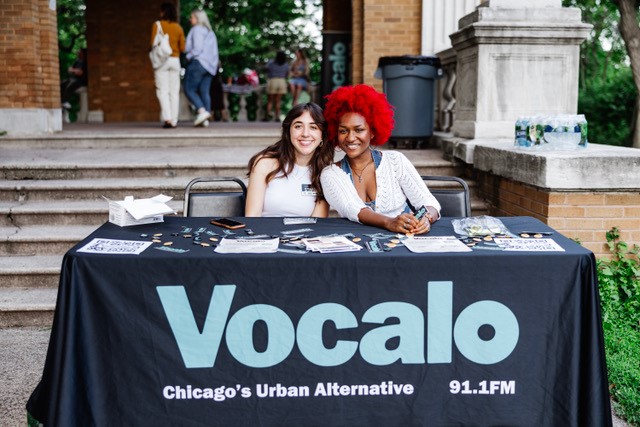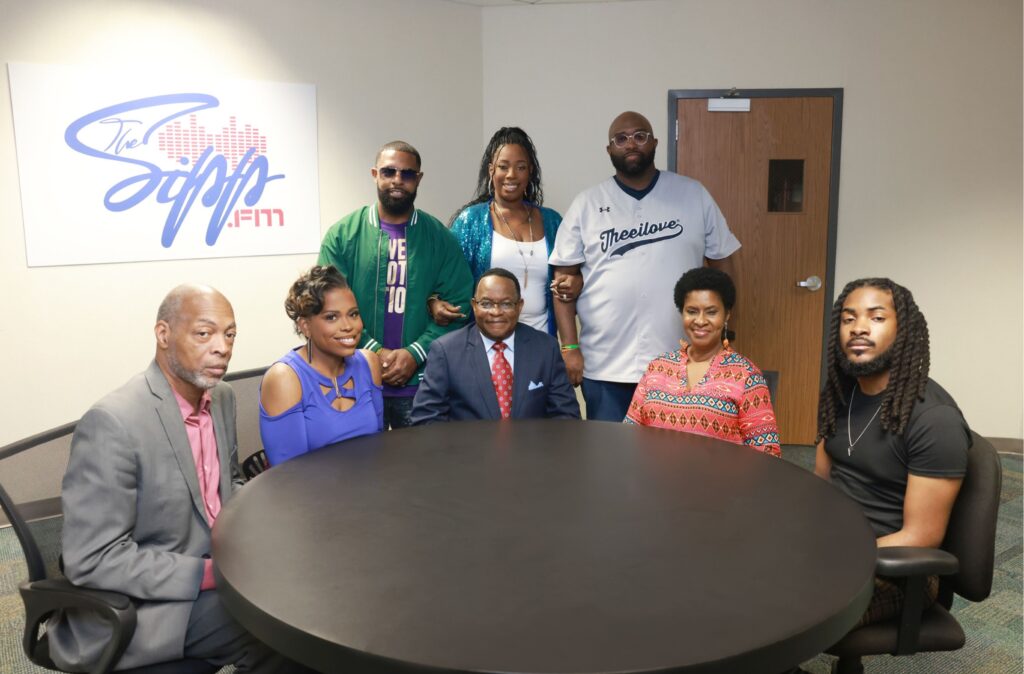
Photo credit: Chicago Public Media.
The new format is building momentum nationwide and finding institutional support as adaptive, audience-first radio that targets an underserved community within the public radio space.
When speaking with any noncommercial station, one thing is always clear: they care about their community. Now, picture a station not just helping that community find new music but actually cultivating an entirely new format completely around them. This is the radical idea behind Urban Alternative, a forward thinking format that’s spread across the country’s airwaves over the past decade, extending beyond a music genre to put a new audience at the center of this radio revolution.
On the vanguard of the revolution is Chicago’s public radio music station, Vocalo. The station, which originally derived from WBEZ in 2007, is considered by many to be the first station to embrace the Urban Alternative moniker. Starting in those early years with a bold experiment of directly accepting and airing submissions from the community, the station began more formally building its playlists in 2010 after realizing the opportunity to highlight the growing support and popularity for hip-hop, R&B, and dance music. In 2014, the station officially rebranded and changed their motto to “Chicago’s Urban Alternative,” emphasizing their connection to Chicago through their unique mix of on-air music. This rebranding kicked off the modern understanding of the format, from playlists to station organization. For Tracy Brown, Chief Content Officer of Chicago Public Media, who oversees Vocalo, there’s excitement in being the new way to think about radio. “I do think that the format allows you to do that in ways that you may not be able to do in other spaces as well. And I love that it’s not so narrowly defined.”
Brown shares that the success of their newsletter, The Goods, which doubled their in subscribers in the last year and has seen a tenfold increase in the last three, helps form deeper connection with its audience. “We have an opportunity to really evolve in new ways, in digital spaces and on social where the people who really are the heart of the Vocalo community are experiencing their music and having important conversations and dialogue in those spaces,” she explains, “We have to continue blaze the trail of how we make those connections.”
Urban Alternative, with its diverse musical tastes and ways of communication, was built around a desire to attract an audience long sought after in noncommercial radio: younger audiences, notably Black and Latino listeners. And with a good reason: a recent Nielson study showed 42 percent of Black Americans use radio for music discovery, and that Black 18-to-34-year-olds use radio 20 percent more than the general US population for this purpose.
Key to the growth of the format and focus on this important audience has been the continued support of the Corporation for Public Broadcasting (CPB), which has championed Urban Alternative since the 2010s. It was the CPB who provided some of the earliest and most integral support for Vocalo through its shift into the format. Since then, CPB has offered three rounds of grants specifically to upstart Urban Alternative stations, supporting Rocky Mountain Public Media’s 104.7 The Drop in Denver, CO, KTSU’s The Vibe in Houston, TX, WNSB’s Hot 91 in Norfolk, VA, Radio Milwaukee’s HYFIN, Minnesota Public Radio’s Carbon Sound, and WJSU’s The Sipp in Jackson, MS. Through these grants and consultation from groups like Paragon Media Strategies, CPB has helped stations across the country to adopt and develop the format, recognizing its potential to redefine noncommercial radio. With early rounds of support led by Erika Pulley-Hayes, then CPB’s vice president of radio, the work now is done through the leadership of Jacquie Gales Webb, the current vice president of radio. She’ll be the first to share the growth of the format on-air and beyond–with successes in new forms of direct fundraising, experiments with digital platforms and content, and growth in more online-forward outreach, such as Vocalo’s approach with their development of its newsletter. Webb sees them as the vanguard of not just public music stations but the entire radio industry, something that takes real commitment. “I’m excited by the courage of the stations that took this on. It wasn’t easy. It’s very hard to start something new,” she admires. “That’s exciting to me and keeps me going. I do have faith that these stations will succeed and we’re going to do our best to help them.”

Photo credit: The Sipp.
For the programmers building this new format, this mission comes not just with an aim to attract a new audience, but to actually serve them, acknowledging that radio often operates within niche perspectives. For Tarik Moody, program director at HYFIN, Urban Alternative has been a collective project to actively address some issues in the noncommercial radio landscape. “We always believed that public radio has done a disservice for people of color and not really truly representing all of the public.” He also recognizes the need in his community. “We’re trying to address the issue that there was never an alternative station for Black audiences, for Black music,” says Moody.
With these new audiences, especially Gen Zers, hesitant to commit themselves to the boundaries of a musical genre, Urban Alternative has learned to adapt. While other noncommercial formats like Triple A are also loosely defined, these new stations lean into a desire to always make the music mix unique to their city, infusing even more local genres and specialty shows into the programming. “When we talk about Urban Alternative, it is not necessarily easy to define it as just a genre of music because it’s R&B, it’s jazz, it’s also Latino music,” lists Brown. “It’s more than just a format. It’s really about the community of the artists and the fans and us being able to help connect those two in a deeper and richer way.”
The format thrives in noncommercial spaces, where that connection and freedom from commercial pressures allows for a more authentic representation of culture and issues often not prioritized in mainstream radio. “Our goal is to be a model and show that public radio is missing out on a whole audience,” says Moody. “We need to authentically engage with communities of color and reflect the true diversity of the public.”
The excitement for Urban Alternative extends beyond the stations themselves. “We have to be addressing a younger audience and a more diverse audience. I think the Urban Alts are serving as an incredible example of how to really buckle down and connect with the community first and foremost,” explains Jessica Weber, owner and founder of independent radio promotion company co-sign. The company, one of many that connect labels and artists with stations, is a leader in promoting records aligned with the format. Urban Alternative was recently recognized in Mediabase, an industry-leading airplay tracking service that acts as a basis for many public-facing radio charts, such as Billboard’s, a testament to the format’s growing influence. Weber sees this kind of recognition as a positive sign. “I think that as Urban Alternative continues to figure out its identity, and [the stations] start to come together as a format, and there starts to be those records where everybody’s playing and everybody’s getting behind and everybody’s getting excited, then there becomes real strength in numbers.”
Nikki Swarn of The Drop discussed her station, one of the earlier recipients of a CPB grant, stating she focused on the need to start the conversation by having diverse voices not just on-air but in the station itself. “That training, connective tissue and support is important. You can hire a diverse staff, but if there is no earnest and genuine support, people will not stay. And why should they?” she asked. When chatting with the General Manager of KTSU, Ernest Walker, about launching The Vibe, he recognized its power to build new talent by connecting the student staff at his station to the wider industry. “I think with launching the Urban Alternative station […] we are bringing the experience to them and educating them at the same time.”
It’s a cultural movement redefining what radio can be. “We’re trying to connect the culture. We’re giving them a home and we want to let our audience know that they are valued.” says Moody. Urban Alternative flourishes in the adventurous environment of noncommercial stations because it offers something that commercial radio cannot: authenticity, diversity, and a deep connection to the community.
In doing so, they are not only providing a platform for diverse music and voices but also fostering a sense of community and belonging for audiences often overlooked by mainstream media. Webb, who has been working in radio for over 40 years, sees the power of rethinking what doesn’t work and building on what does. “We have to learn. We can’t keep doing the same. I mean, some traditions are best practices. Some need to be reexamined according to the changing atmosphere or conditions that you’re working in.” As this format continues to grow and evolve, it stands as a beacon of what radio can achieve when it truly listens to and reflects the voices of all its listeners.